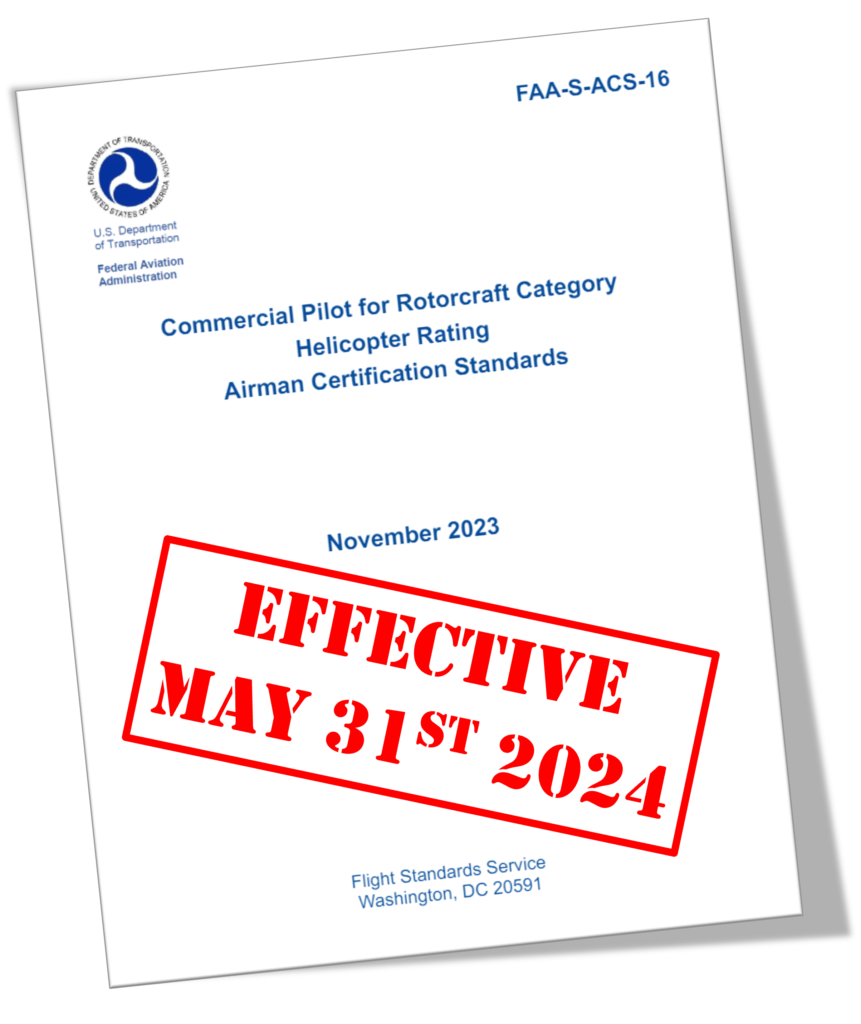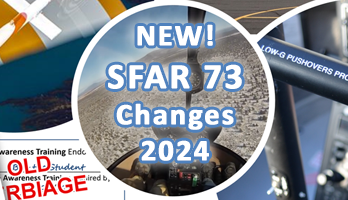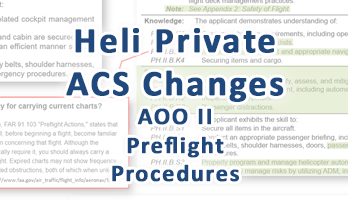Effective May 31st, 2024 the FAA Helicopter Commercial PTS (along with Private, Instrument & CFI) will be replaced by the new FAA Helicopter Commercial Pilot ACS (Airman Certification Standards). In this article we will cover the BIG changes from PTS to ACS for the Helicopter Commercial Pilot.
General ACS Changes
But first, if the ACS is completely new to you, before reading the specific changes below check out our ACS overview article and ACS overview video covering the new ACS code system, task structure, required elements, changes to special emphasis areas, risk management and more.
Follow Along
If you want to follow along with the changes, grab the free PDF from the FAA’s ACS webpage or purchase the paper version (Amazon affiliate links to help support HTV) below. Paper versions also come with the ACS Companion Guide for Pilots (FAA-G-ACS-2).
Helicopter ACS Commercial Pilot – The BIG Changes Video
Two New Instrument Tasks!
Yes, you read it correct – instrument tasks now in the Commercial checkride! Just like the new Helicopter CFI ACS, the FAA have added these two new instrument tasks. But unlike the CFI ACS (where these tasks are optional), these two new tasks are required for every Commercial ACS checkride!
These are really big changes, because most flight schools use R22 helicopters for Commercial and CFI training and most of them are not equipped to fly by reference to instruments. So that may mean a costly upgrade to include instruments like the GI-275 in the training fleet, or use of an R44 for part of the checkride. Any R22s upgraded to have an attitude indicator will increase safety, as going inadvertent IMC in a helicopter without an attitude indicator means almost certain death.
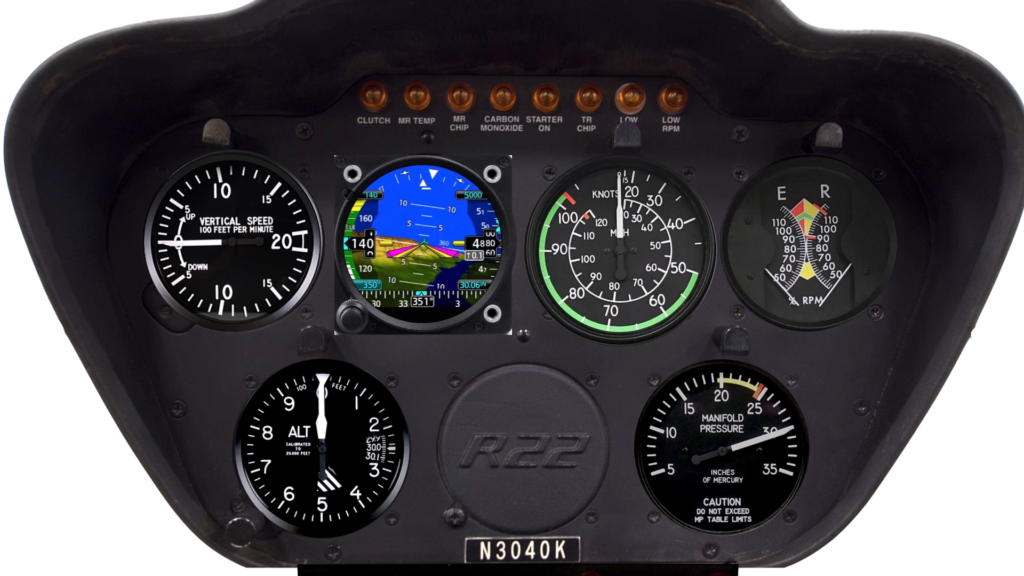
Task L – Flight Solely by Reference to Instruments
Task L is a basic exercise in flight by reference to instruments. It involves holding a constant airspeed (±10 knots) straight and level, holding altitude within ±200 feet and heading ±20°. The fun begins when you must make a constant airspeed climb and descent, wings level as well as with turns to a specific heading, stopping the climb/descent within ±200′.
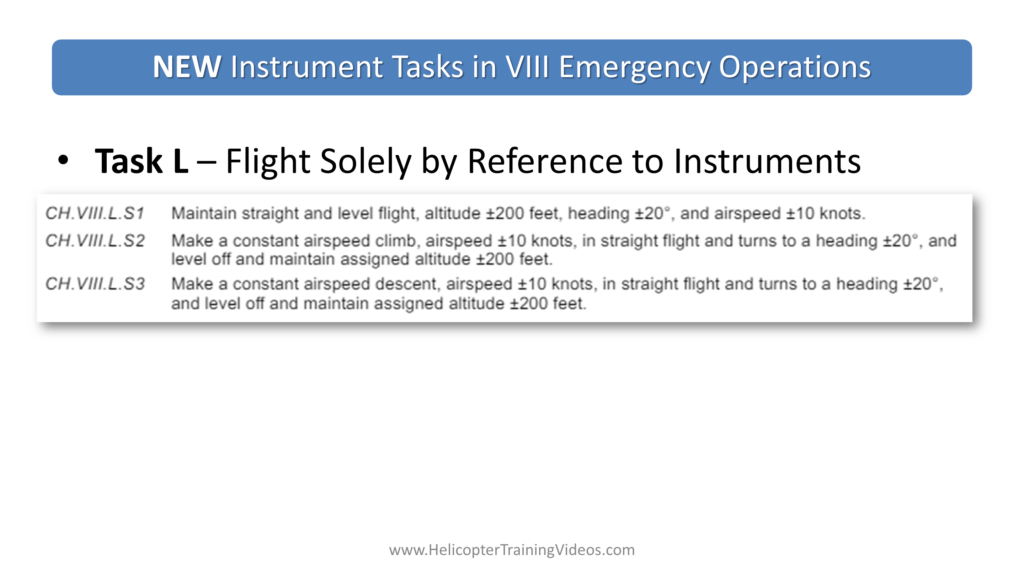
A good training exercise for this would be something like “Fly heading 180, maintain 5,000 and 60 knots“, once stable “Right turn heading 360, climb maintain 5,500 at 60 knots“. And then reverse “Left turn heading 180, descend and maintain 5,500 at 60 knots“.
Task M – Recovery from Unusual Flight Altitudes
Task M – if you have done your instrument rating this maneuver should be familiar to you. Recovery from unusual attitudes, one nose up and one nose down. There is also an Appendix 3 reference that reminds you not to do a push-over (mast bumping) or aggressive aft cyclic (causing an overspeed).
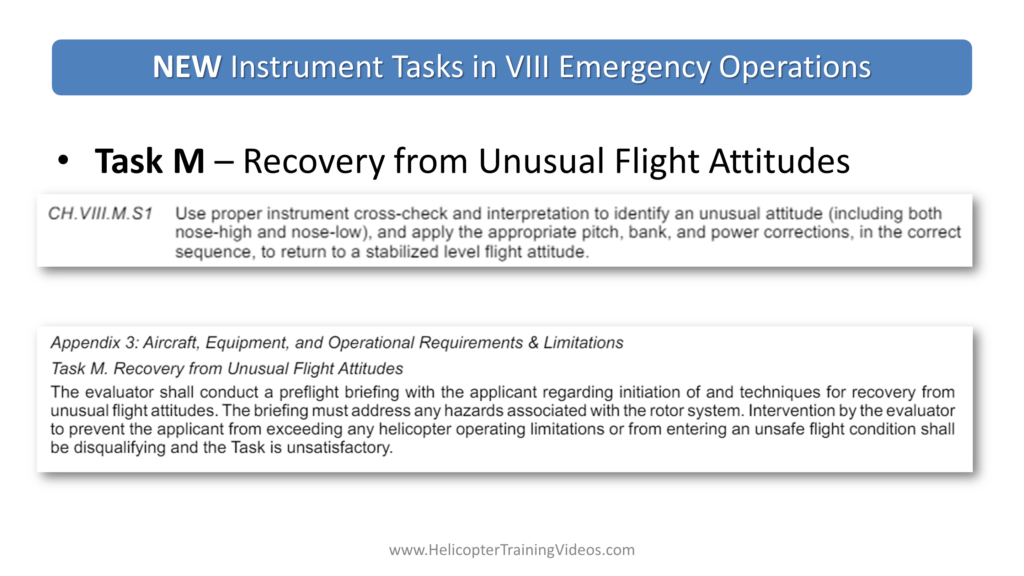
New Antitorque System Failure Task
There used to be an optional antitorque failure element under Task C (Systems & Equipment Malfunctions) in the PTS. But now this is its own full task and is a a required (discussion only) task.
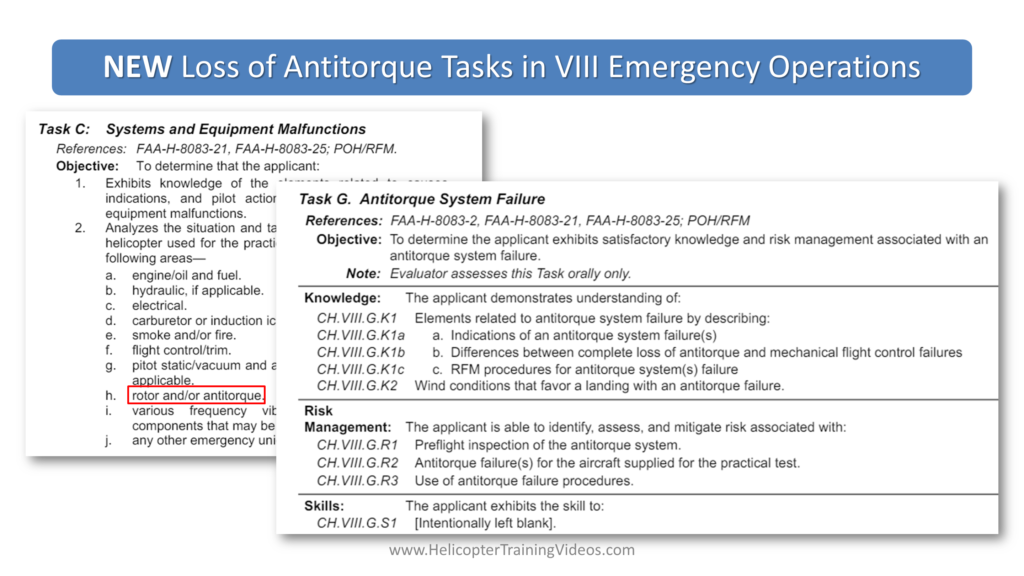
Some interesting elements to consider:
- Difference between complete loss versus control failure (stuck pedal)?
- Wind conditions that favor a landing with antitorque system failure?
- In the R22 & R44 I would say a good headwind to reduce ground speed on contact.
- Other aircraft may use a running landing, and may have details in their RFM on specific favorable wind directions.
Air Taxi Altitude
The Commercial ACS changed the air taxi altitude target from ±5 to ±10 feet. But remember you still need to specify to evaluator what your target altitude is going to be (usually 40 feet).
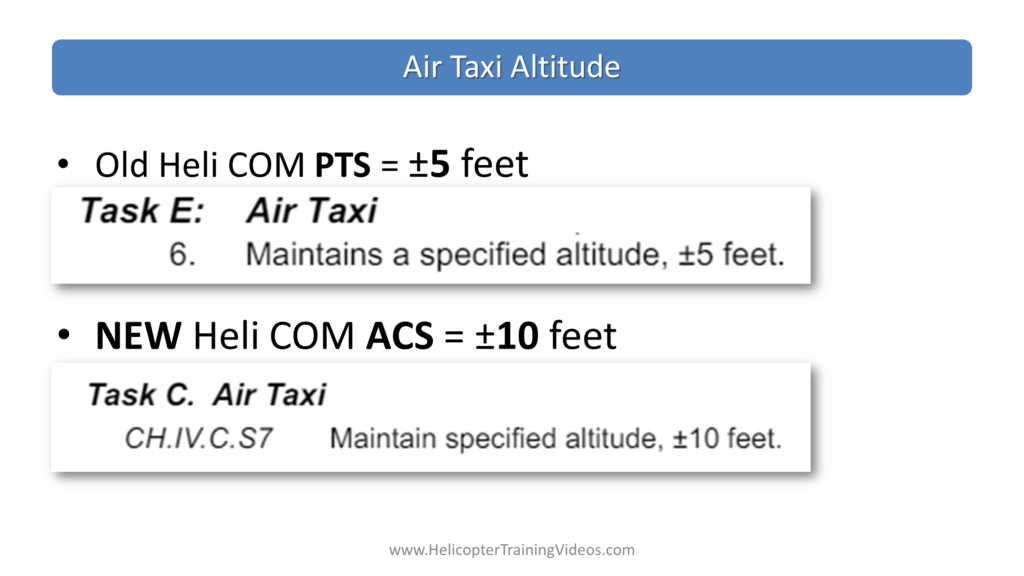
New Navigation Standards
The PTS had no objective standard for tracking a course, radial or bearing for Commercial. Now the Commercial ACS requires you to maintain ±10 heading & ±100 feet using an airborne electronic navigation system (GPS typically). The new Private Pilot ACS also has this change, but it has less stringent standards ( ±15 heading & ±200 feet).
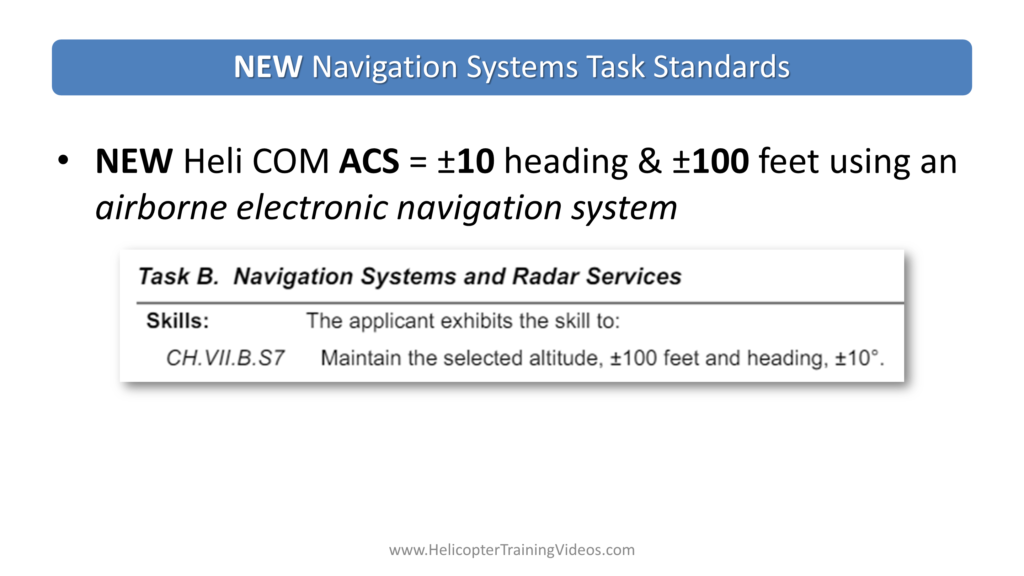
Autorotation 300′ AGL Rollout
The new Helicopter Commercial Pilot ACS (as well as Private and CFI) has added a requirement to complete turns by 300‘ AGL for the 180 autos (renamed autorotation with turns). The ACS Appendix 2 (Safety of Flight) says that if the applicant fails to roll out of the turn by 300‘ AGL, the evaluator will require the applicant to initiate a power recovery and go around, and the task will be graded as unsatisfactory. It also requires a minimum entry of 700‘ AGL.
For many this will probably require an adjustment in training to enter at a higher altitude. Apart from the obvious improvement to safety, I think this is a good thing as a higher altitude entry will allow more time for the applicant to make adjustments to hit their spot.
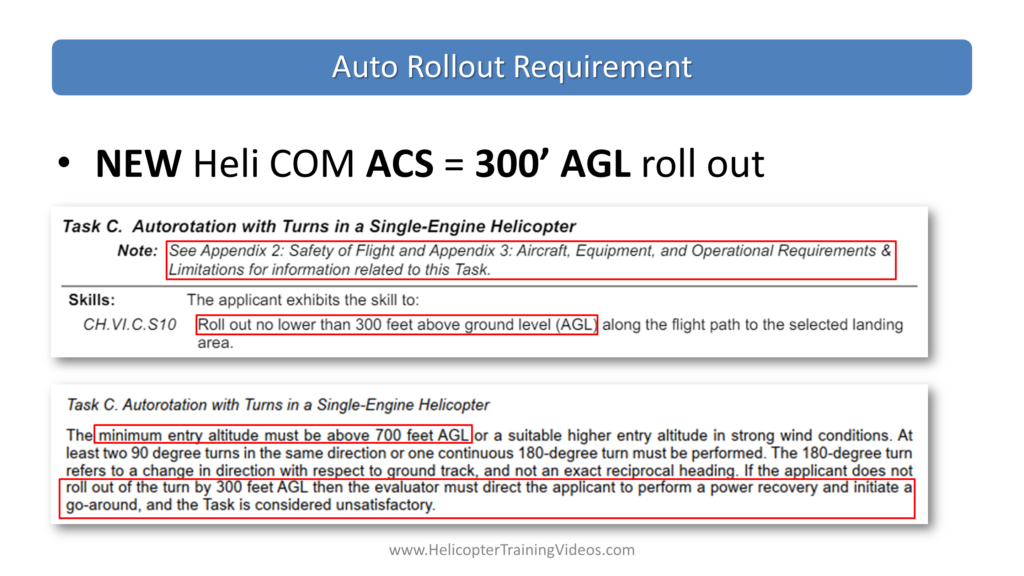
Flight Deck Management
The task has been renamed from Cockpit Management, but the content itself is not too different. But the big difference is the note to Appendix 2, which says if the applicant fails to use ADM SRM/CRM on any task, that task will will be unsatisfactory and the applicant will also get a Flight Deck Management unsatisfactory task too – bonus fail!
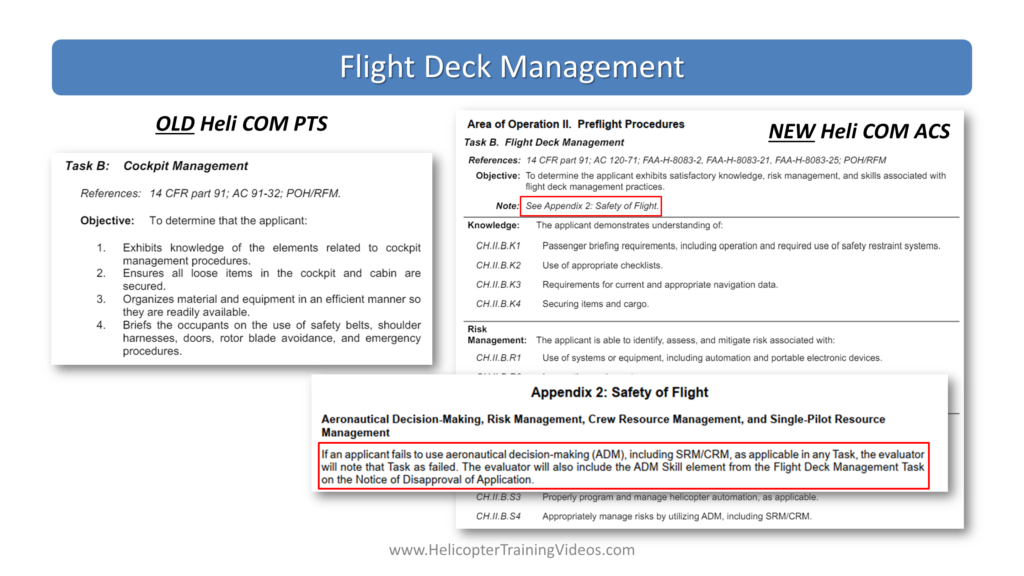
New, Renamed & Reordered Tasks
A big part of the changes from PTS to ACS is the renaming, reordering, removing and adding of tasks. The following is summary of the changes for the Helicopter Commercial Pilot from PTS to ACS for each area of operation (AOO). This is just the task name & order changes – full details of what elements actually changed within every task will require you to read every line the ACS, as you should for full preparation for a checkride!
I. Preflight Preparation Tasks
Task A is renamed from Certificate and Documents to Pilot Qualifications because the task items that related to the aircraft certificates and documents were moved into Task B (Airworthiness Requirements) and Task A became pilot-focused.
Task H was renamed Human Factors from Aeromedical Factors, but the content area is mostly the same.
Task I (Physiological Aspects’ of Night Flying) & J (Lighting and Equipment for Night Flying) were removed and combined into the new Task I (Night Operations) with some new added elements.
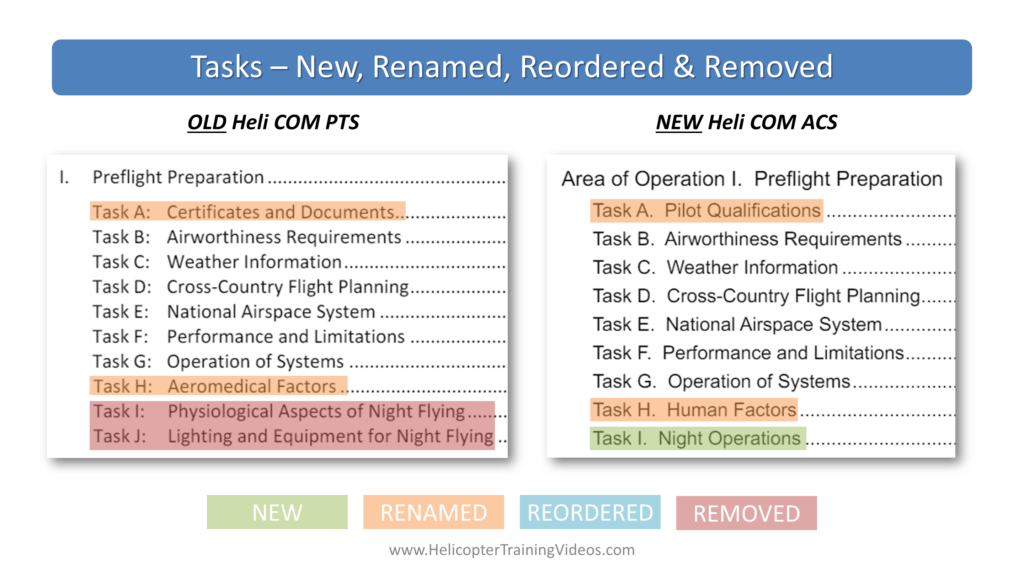
II. Preflight Procedures Tasks
Some minor tweaks to the task names:
- Task A renamed Preflight Assessment
- Task B changed to Flight Deck Management (with details covered above)
- Task C replacing “engine” with “powerplant” (probably to future-proof as we move to electric propulsion, etc.)
Also Task D (Runway Incursion Avoidance) task has been removed and been absorbed into the new Risk Management elements of maneuver tasks like Hover Taxi, Air Taxi Tasks, Takeoff & Landing.
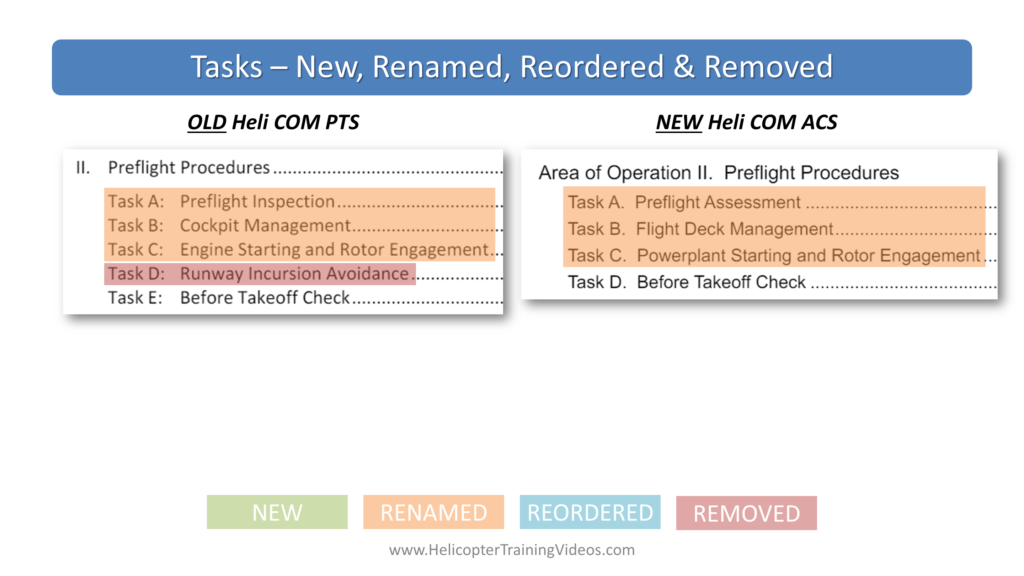
III. Airport & Heliport Operations Tasks
Some reordering and renaming, in particular adding Runway Status Lighting Systems to the communication task name. That would include lighting that communicates to the pilots such as the
Runway Entrance Lights (RELs) which provide visual signals to aircraft crossing or entering a runway from intersecting taxiway and the Takeoff Hold Lights (THLs) that provide visual signals to aircraft in position for takeoff. This is an area to study in the AIM and the FAA Runway Status Light Systems webpage.
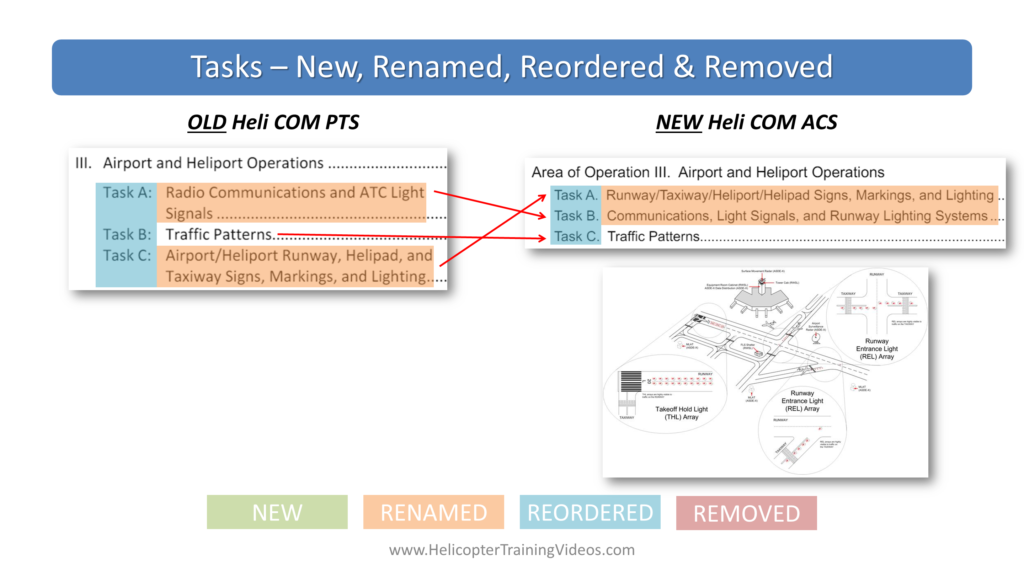
IV. Hovering Maneuvers Tasks
Some reordering and a minor name change to clarify surface taxi is for helicopters with wheels only.
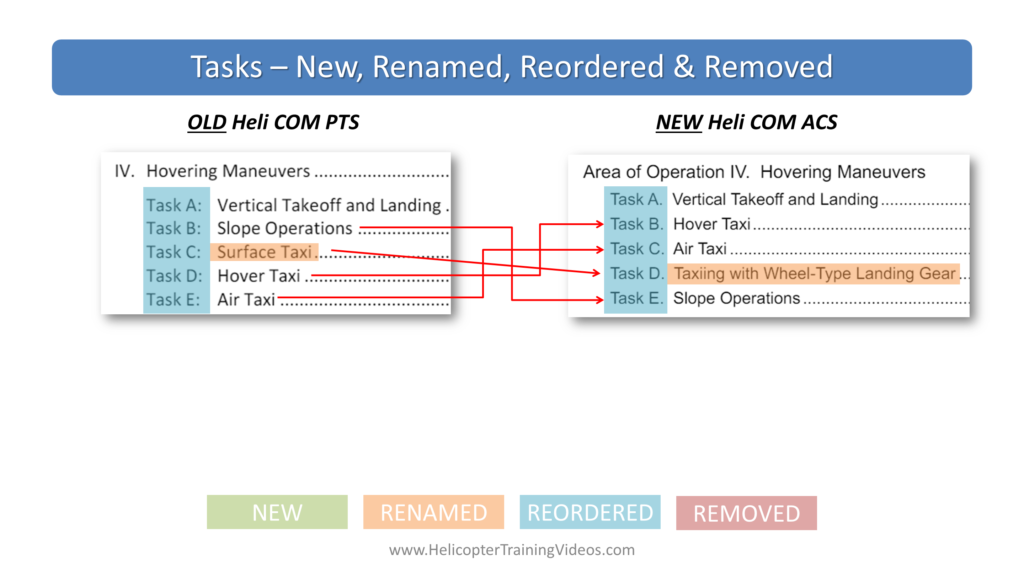
V. Takeoffs, Landings and Go-Arounds Tasks
The takeoff task has “crosswind” removed from task name, but crosswind is still part of the task. Also it is strange that they left “crosswind” in the approach task. They also added clarity to rolling takeoff task only being for wheeled aircraft.
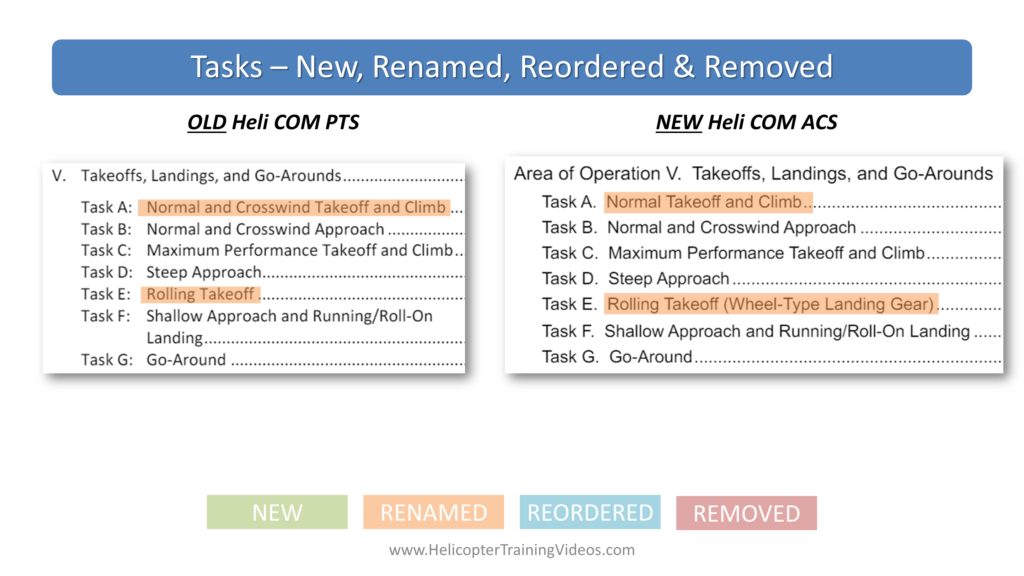
VI. Performance Maneuvers Tasks
FAA has gone back to using “Quick Stop” as a way to describe a rapid deceleration maneuver. They also added “Single Engine” clarification to both autos. They renamed 180 autos to be autos “with turns” – but it is still the same task essentially – you must end up 180 degrees from entry, just added clarification that it can be multiple turns to make your spot, not just one continuous 180 degree turn (with the 300′ AGL rollout requirement already covered). They also moved the single engine approach (Task D) to the Emergency Operations area of operation.
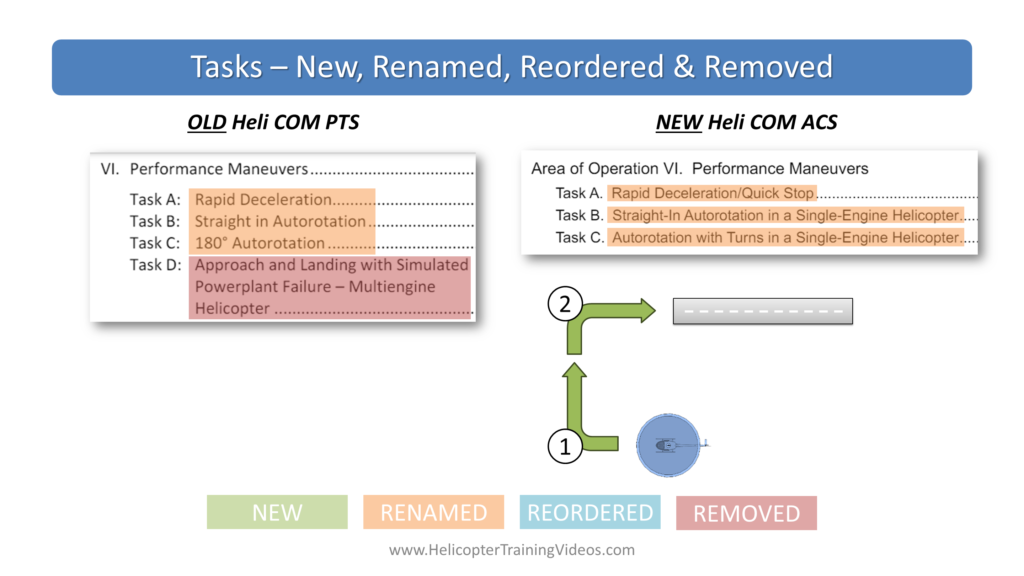
VII. Navigation Tasks
No changes to the task names or orders in the Navigation area of operation. But remember, that is just the task titles, the content of every task has new elements – you must read through the full ACS line by line.
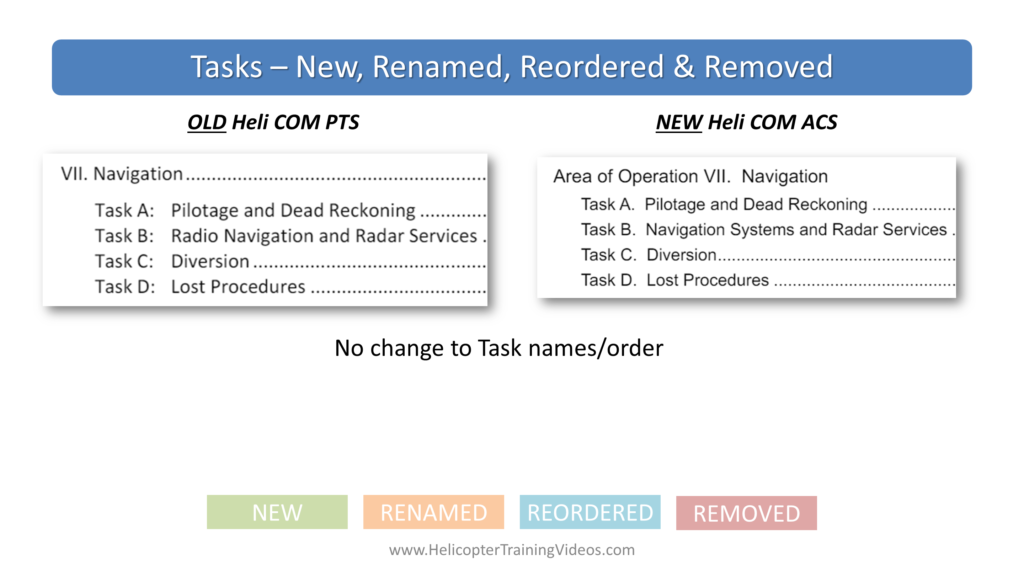
VIII. Emergency Operations Tasks
A few name changes:
- Task A & B added clarification that autorotation tasks will be in a a single engine helicopter.
- Settling-with-Power was renamed to Vortex Ring State.
- Last two minor tweaks were spelling out what “G” means in low G and what “RPM” means.
A new task was added for single engine approach in multi engine helicopters (moved from Performance Maneuvers area of operation VI). The addition of that task pushed all other tasks down one but the order remained the same. And we already covered the new Antitorque System Failure task (task G) and the two new instrument tasks (task L & M).
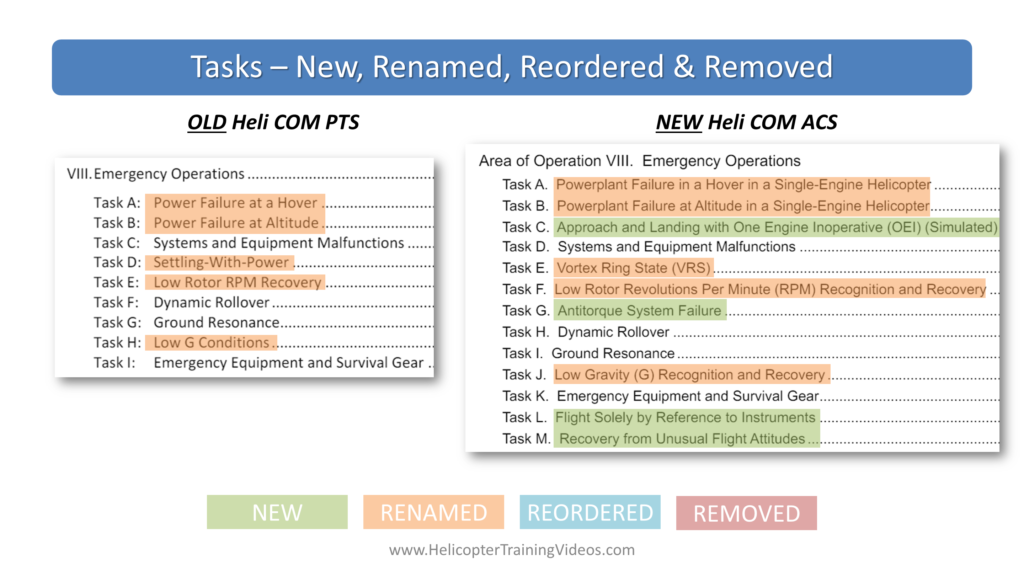
IX. Special Operations Tasks
There was a minor change to Task B, removing “platform”. But platform operations are still mentioned in the task elements.
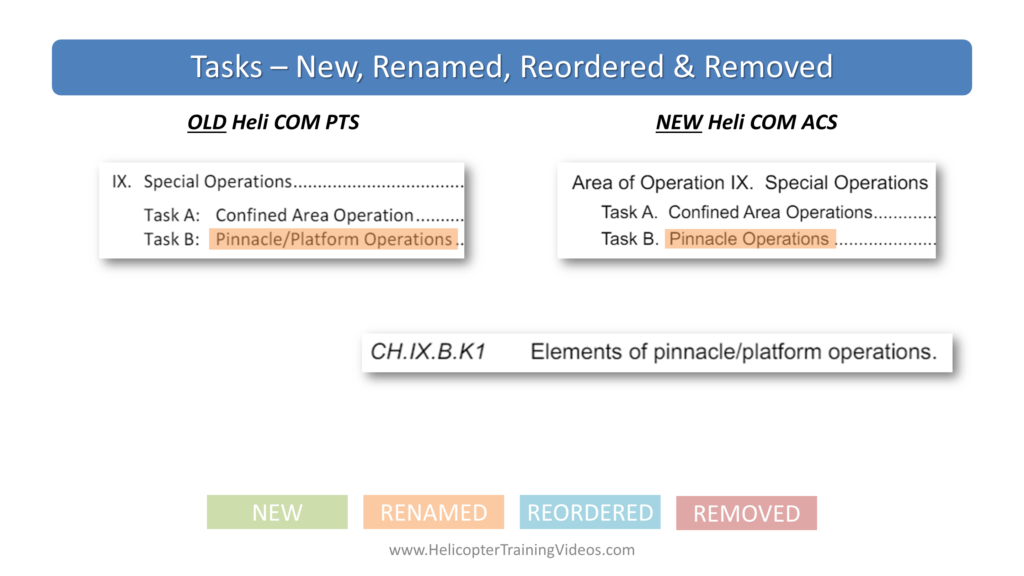
X. Postflight Procedures Tasks
The word “parking” was added to the title, but it is not a new element.
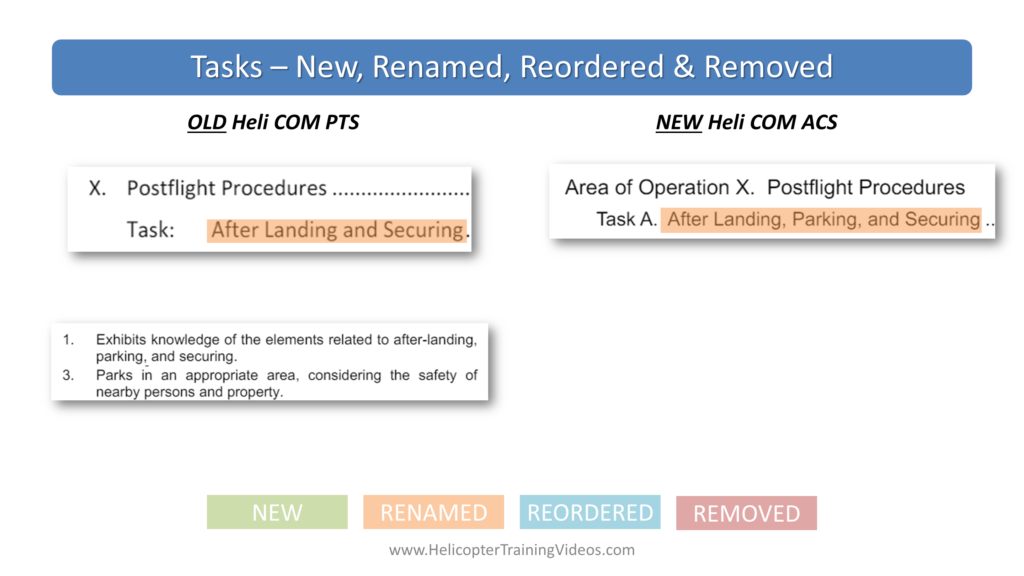
More Info
To learn more about the change from Helicopter PTS to ACS, check out the following:
- Helicopter ACS General Changes Video and article
- Helicopter ACS Playlist (Full Details for PVT, COM, INST & CFI Changes)
- FAA Airmen Certification Standards
- ACS Companion Guide for Pilots (Nov 2023)
- Short WINGS course on ACS
- LSR (PTS) Codes List
- ACS Tips for Evaluators (includes SBT ideas)
If you want to purchase the paper versions below are Amazon affiliate links that help support HTV. Paper versions also come with the ACS Companion Guide for Pilots (FAA-G-ACS-2).
DISCLAIMER – make sure you are fully informed on the latest regulations and their application.
For official guidance on laws and regulations, refer to your Certified Flight Instructor (CFI) or local Flight Standards District Office (FSDO) . Helicopter Training Videos aims to promote aviation knowledge and safety but makes no guarantees regarding accuracy or legal applications.
Feedback
What big changes to the Helicopter Commercial Pilot ACS have you seen? Let us know using the comments form below:




